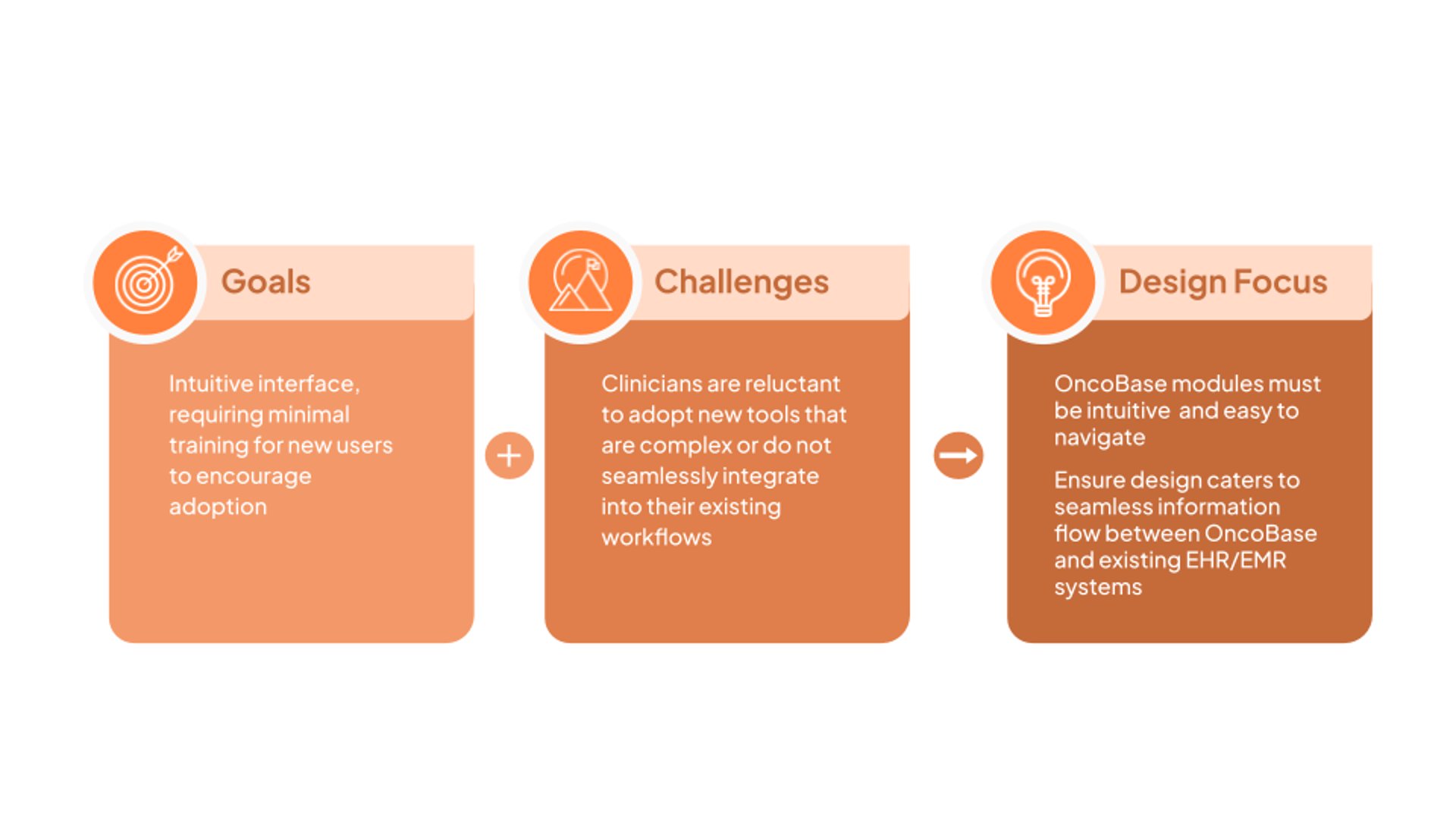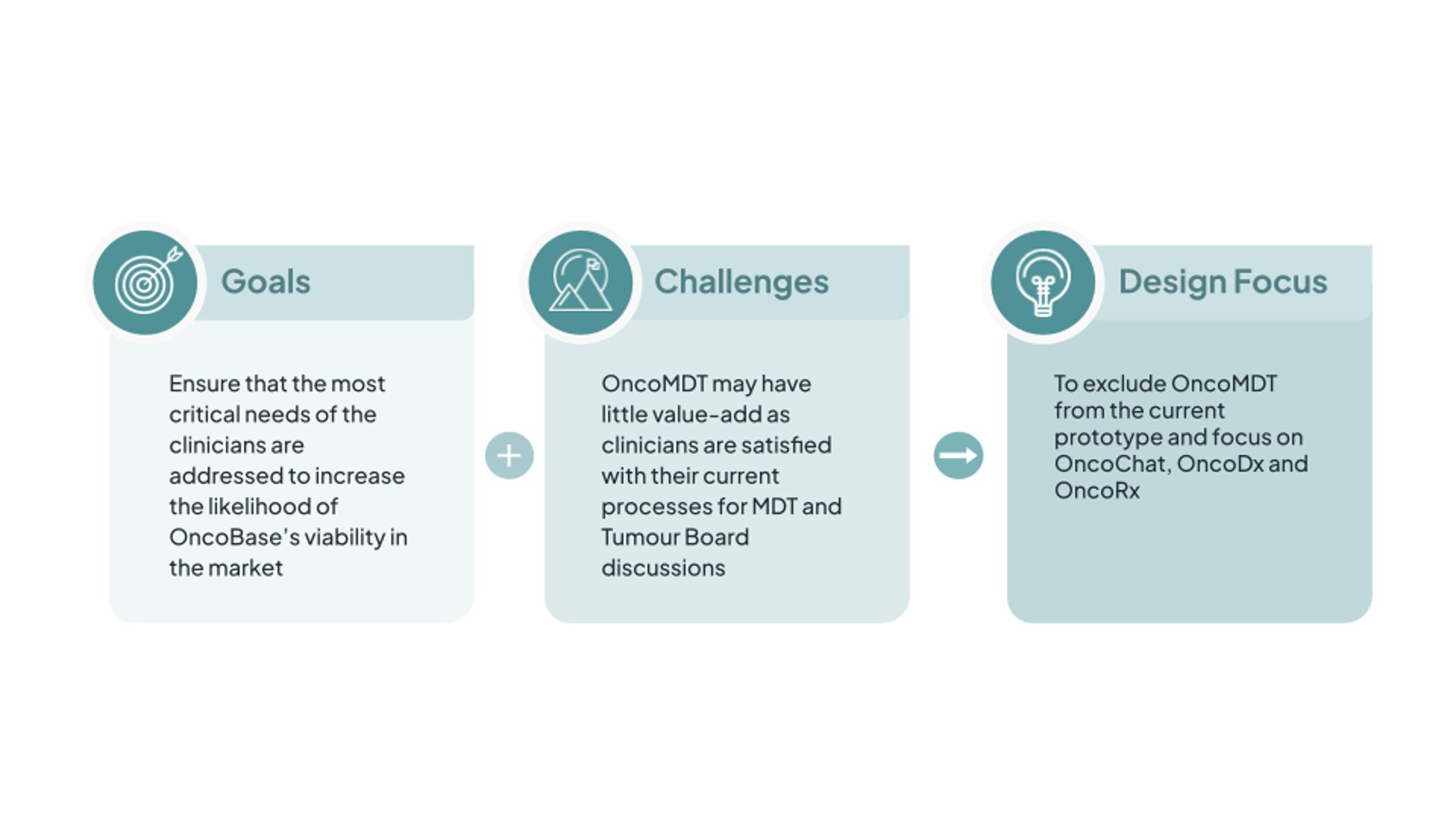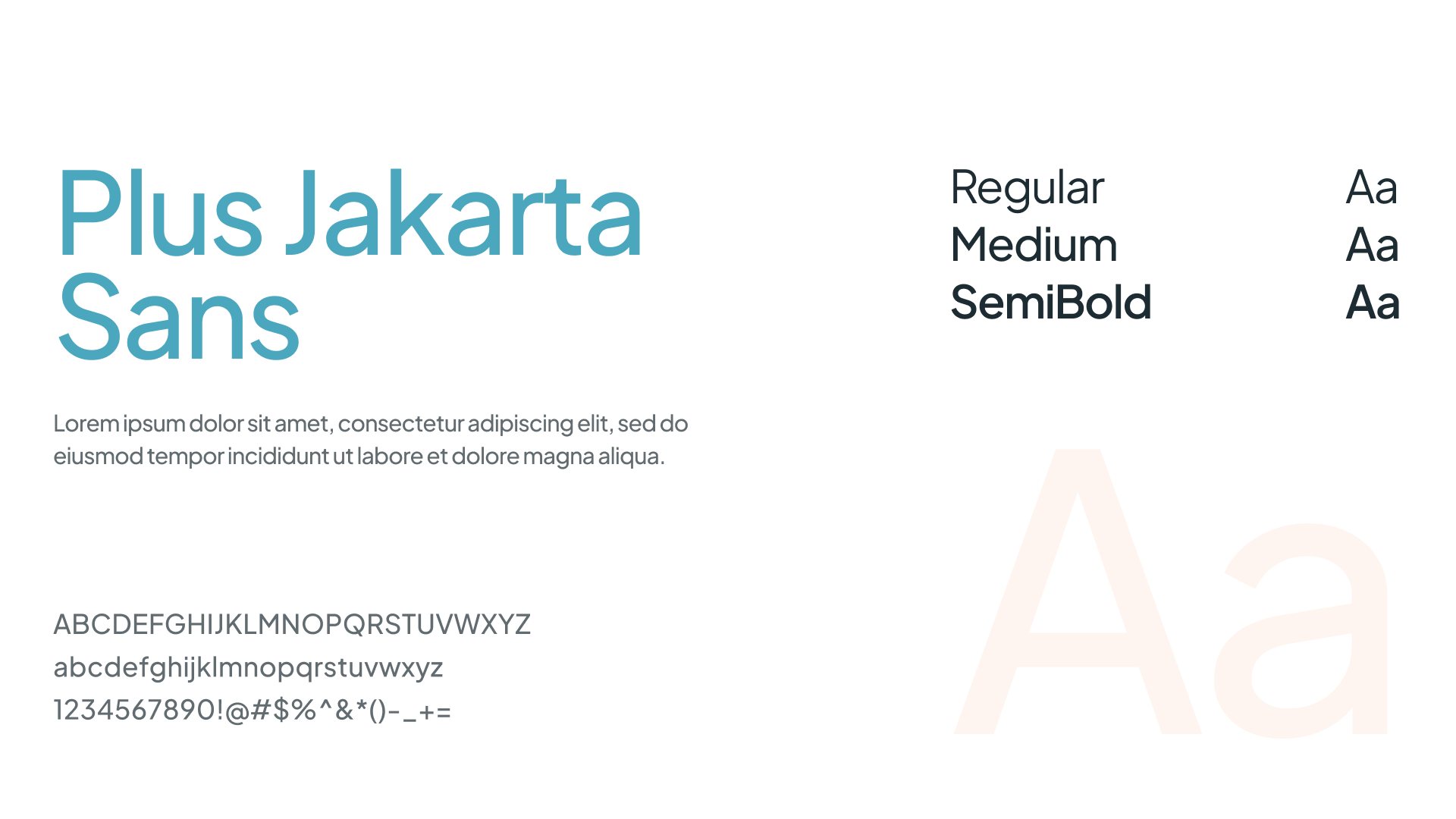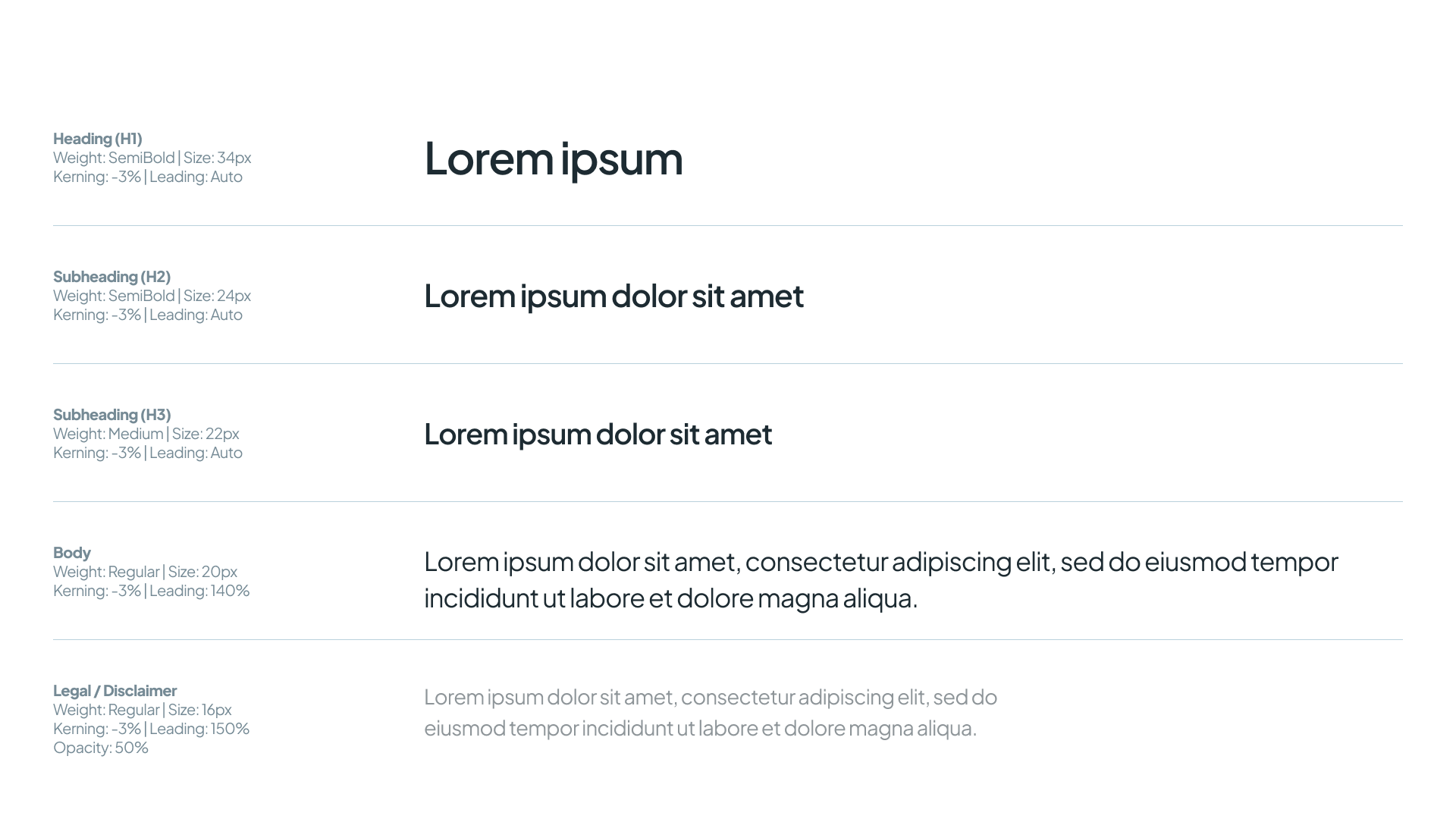
Discover
The product
Connectify.ai is a specialized platform that supports oncologists by integrating AI into cancer care management.
The OncoBase software centralizes crucial clinical data, research, and patient information, helping healthcare professionals make informed decisions in treatment planning. By leveraging AI-driven insights and data analytics, OncoBase aims to streamline workflows and improve the precision of personalized care.
Our goal: Optimizing User Experience for Enhanced Cancer Care Solutions
In this project, our team focused on redesigning both the software platform and user experience (UX) of the OncoBase modules, ensuring that the system is intuitive, efficient, and tailored to the needs of oncologists.
Timeline
In this project, our team focused on redesigning both the software platform and user experience (UX) of the OncoBase modules, ensuring that the system is intuitive, efficient, and tailored to the needs of oncologists.


Market Analysis
We comprehensively analyzed leading AI-powered oncology platforms to benchmark OncoBase against its competitors. These comparisons helped guide our redesign of OncoBase, emphasizing intuitive data management, advanced AI capabilities, and seamless integration with clinical workflows to provide an optimized user experience. Our evaluation of leading oncology platforms reveals distinct market positions:






PathAI dominates AI-driven digital pathology, excelling in diagnostic accuracy through streamlined image analysis and single-screen workflows, though its lack of multi-omics integration limits holistic insights.
Artera advances precision oncology with predictive treatment guidance, synthesizing genomic and clinical data into clinician-friendly simulations, yet requires extensive training to build trust in its AI outputs. Meanwhile,
Allscripts Sunrise remains entrenched as a hospital-scale EHR, prioritizing administrative efficiency over innovation, with no native AI tools and navigation complexities that prolong clinical workflows.
While PathAI and Artera demonstrate the transformative potential of specialized AI, both struggle with cross-disciplinary data synthesis—a gap OncoBase strategically addresses by unifying diagnostic, genomic, and operational insights within an intuitive, clinician-first interface designed for adaptive learning and multidisciplinary care coordination.
Define
Primary user research
Our primary user research revealed significant challenges faced by oncologists in keeping up with advancements. One major issue is the overwhelming volume of information available online. Oncologists frequently research cancer journals to stay updated, but filtering through this vast data to find relevant content can be both time-consuming and inefficient. Much of the information may not directly apply to their current practice. Despite our efforts to secure interviews with multiple oncologists, we only managed to speak with two. Their feedback highlighted how the sheer volume of data makes it challenging to identify and integrate useful insights into their practice.
Challenges in Keeping Up with Oncology Advancements
Oncologists often conduct online research for relevant cancer journals but struggle to filter through vast amounts of information that may not be directly applicable to their practice.


Constraints Placed by Established Clinical Protocols and Guidelines
Integrating new knowledge into daily practice is challenging due to time constraints and the relevance of research to current cases.
Constraints Placed by Established Clinical Protocols and Guidelines
Oncologists rely on established protocols, limiting personalized treatment options, as prescribing is restricted to approved cancer drugs and insurance coverage further narrows drug availability.
Skepticism with AI
Oncologists are cautious about fully relying on AI, viewing it more as a supplementary tool, particularly useful for trainee doctors as a secondary resource.
Secondary user research
As we have very limited primary data from interviews with our actual target group, we have supplemented our findings with secondary research through literature reviews. Our secondary research highlights a significant challenge faced by oncologists: keeping up with the rapid advancements in cancer research and treatment protocols. The sheer volume of new research, combined with their demanding workloads, makes it difficult for oncologists to stay current. This overwhelming influx of information adds to the complexity of integrating new knowledge into their practice, emphasizing the need for more efficient methods to manage and apply the latest advancements.
Difficulty in Keeping Up with Oncology Advancements
Oncologists struggle to keep up with rapidly advancing cancer research and treatment protocols due to the overwhelming volume of research and their demanding workloads.


Concerns about Reliability and Accuracy of AI Tools
Many oncologists are concerned about the accuracy of AI-powered tools, fearing they may not always align with best practices or current guidelines, leading to hesitation in fully trusting them for complex cancer care decisions.
Insights
OncoBase addresses clinicians' skepticism of AI by prioritizing evidence-based accuracy, ensuring AI-generated responses are anchored in peer-reviewed research and updated guidelines to build trust. It enhances usability with an intuitive interface and seamless EHR/EMR integration, minimizing workflow disruption and training time. Market research guided strategic focus on core modules—OncoChat (instant clinical Q&A), OncoDx (diagnostic support), and OncoRx (treatment recommendations)—while deprioritizing redundant features like OncoMDT, as oncologists already value existing multidisciplinary tools. By aligning with critical clinician needs—credibility, workflow efficiency, and actionable insights—OncoBase aims to streamline decision-making and amplify its impact in oncology care.
Persona
The team analyzed user interview data to develop detailed personas for the OncoBase redesign, representing distinct clinician segments such as oncologists, radiologists, and specialists. Each persona highlights unique needs and challenges, accompanied by problem statements, "How Might We" questions, and solution statements to guide design decisions and improve the user experience.


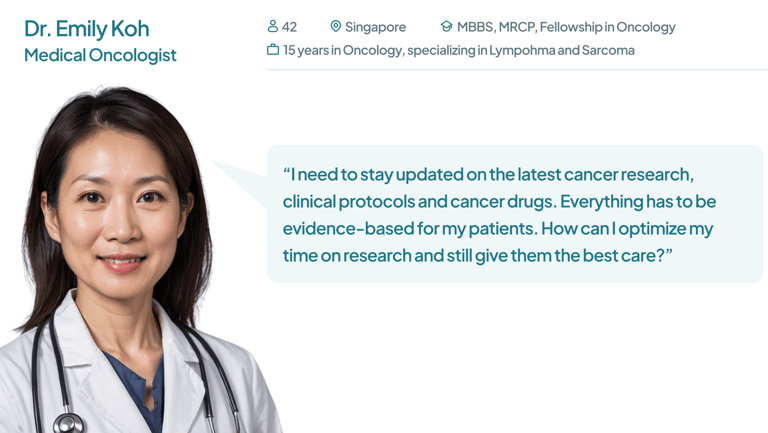

Information architecture
The Information Architecture of OncoBase integrates its key modules—OncoChat, OncoDx, and OncoRx—designed to streamline oncology workflows and enhance patient care.
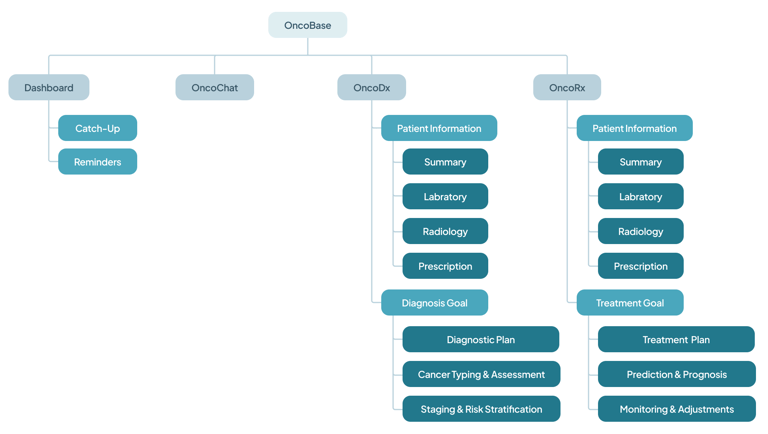

Design system
The initial design system was rather basic and lacked character. We introduced more icons and some vibrant illustrations at key touchpoints to make the interface more engaging. We also revamped the logo, transforming it from a plain text format into a sleek, elegant, and distinctive illustration.
Deliver
User-testing results


We conducted usability testing with 7 family physicians, we chose family physicians due to challenges securing oncologists for this phase. These physicians are familiar with cancer screening and diagnosis through their work. The tests were conducted remotely over Zoom as well as in-person. These tests aimed to evaluate the ease of use and functionality of OncoBase’s core features.


Our System Usability Scale (SUS) scores averaged 78.6, indicating a generally positive response to OncoBase’s usability. Most clinicians completed their tasks within the allotted time, but a few struggled with specific actions. For example, one user skipped the query input step in OncoChat, and was confused when adding a note and collapsing the sidebar. These observations revealed areas where the interface could be refined to better align with clinician workflows.


The physicians offered feedback based on their respective specialties, which may not entirely reflect the specific needs of oncology professionals. However, their insights provide valuable considerations for future development. In the next phase, we can explore implementing some of these suggestions and testing them with oncologists to ensure the tool is properly tailored to its target audience.
For now, our main priority is creating an intuitive and functional design that highlights OncoBase’s essential features. Based on our observations and the feedback from the usability testing sessions, we have identified several key areas for improvement.
Changes made after user testing
Finding: Users would like to be able to edit the results generated on the OncoDx and OncoRx modules before publishing it to the EHR system.
Design Iteration: Introduced an "Edit" button next to the generated results. This would provide a clear and intuitive option for oncologists to modify the information before submission.


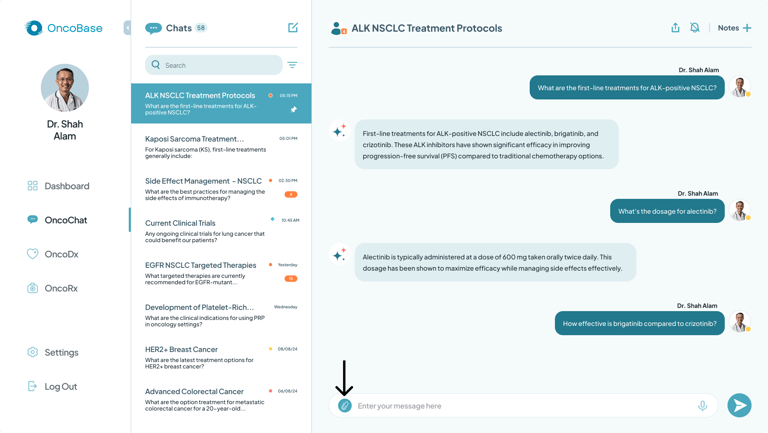

Finding: One participant initially mistook the “+” icon (used to add documents) as the button to send messages in OncoChat, causing hesitation before finding the correct send button.
Design Iteration: Replace the “+” icon with a paperclip icon, which is more universally recognized for attaching documents, thereby reducing confusion and improving task flow.


Finding: Users had difficulty locating drafted diagnoses on the dashboard, as the cases were labeled only by case numbers (e.g., LC-001). Given the large volume of patients, oncologists are less likely to remember case numbers.
Design Iteration: Display the patient's name alongside the case number on the dashboard. This will allow oncologists to identify their cases and avoid unnecessary delays more easily.


Finding: Users were confused by multiple search icons—one within individual chats and another at the list of chats. When tasked with searching for the word “Treatment,” some mistakenly clicked the search icon inside the chat window.
Design Iteration: Remove the search icon within individual chats and retain the one at the list of chats. This will streamline the search functionality, allowing users to search both chat titles and their contents from a single location.
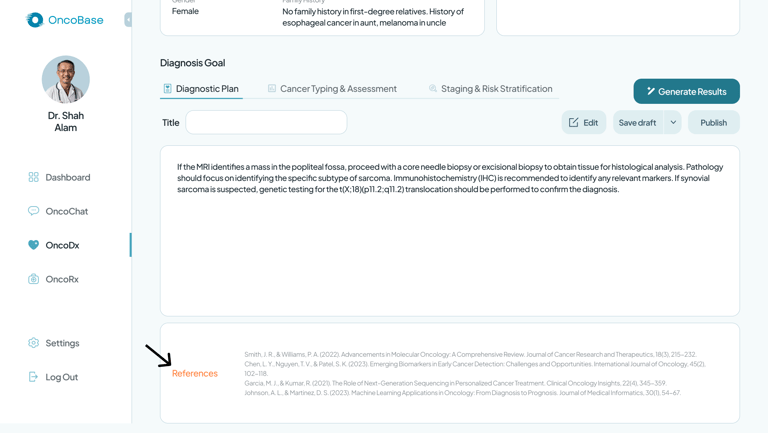

Finding: Physicians preferred clickable links to the sources, as manually searching for references would be too time-consuming.
Design Iteration: Add direct links to all references. This would enhance efficiency by allowing users to quickly verify sources without needing to perform additional searches.
Future opportunities
This early prototype of OncoBase highlights key areas for future development. One critical opportunity is enhancing the depth of patient and clinical information in OncoDx and OncoRx, aligning them with the comprehensive data typically found in EHR/EMR systems. Close collaboration with oncologists is essential to ensure clinical relevance and accuracy in these modules. Additionally, feedback from usability testing suggests that OncoDx and OncoRx could potentially be merged, as overlapping information between diagnostic and treatment planning exists, especially in cases of cancer recurrence.
Clinicians emphasized the need for seamless integration between OncoBase and their current EHR/EMR systems, allowing for customization and smooth data flow. They also stressed the importance of incorporating inputs from other specialties, such as psychiatry and rehabilitation, to provide holistic patient care. Finally, some clinicians recommended adding a news feed on the dashboard to keep users informed of relevant oncology advancements, supporting OncoBase's goal of keeping specialists up-to-date with the latest research and clinical protocols.
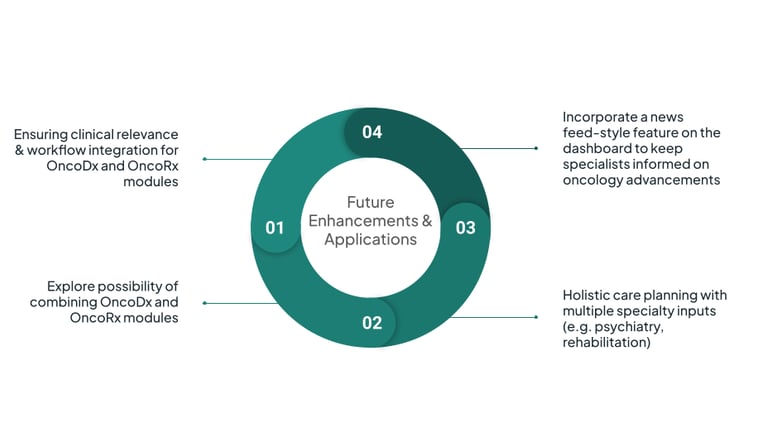

Conclusion
My experience while leading a team in the redesign of OncoBase. While we initially faced challenges due to differing work styles, these differences ultimately proved beneficial by introducing fresh ideas and diverse perspectives into the project.
Through open communication and mutual respect, we successfully navigated these challenges, demonstrating the power of teamwork in achieving meaningful outcomes. This project, although a prototype, highlighted the immense responsibility of designing a platform that would directly impact clinicians' workflows and improve patient care. Recognizing the need for seamless integration with existing systems and addressing clinicians' most pressing needs pushed us to refine every aspect of our design.
Working on the OncoBase redesign not only allowed me to apply my UX skills but also gave me the opportunity to contribute to the future of oncology care. Although this prototype is just an early stage, it’s exciting to see the potential impact it can have on improving how clinicians stay updated on oncology research and manage patient treatment plans. Collaborating with my team on this project was incredibly rewarding and reinforced my passion for creating tools that make a positive societal impact through thoughtful design and innovation.


